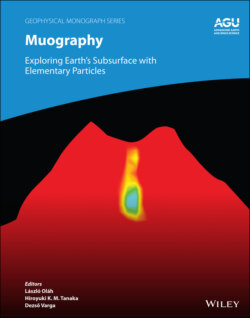Читать книгу Muography - Группа авторов - Страница 39
2.3 FILTERED BACK PROJECTION
ОглавлениеThis section introduces filtered back projection (FBP) of muographic images of a volcano as described in Nagahara and Miyamoto (2018). FBP can be used to solve inversion problems, and is commonly used in the field of medicine. X‐ray computed tomography (CT) is a well‐known technique for examining the three‐dimensional internal density structure of the human body, which involves stacking of numerous tomographic images. The FBP algorithm is based on the Radon and Fourier transformations (Deans & Stanley, 2007), and does not require prior information.
There are some similarities between medical X‐ray CT and muographic volcano CT imaging including, for example, the linearity of the signal beam and attenuation in the imaged material. However, the number of detectors and signal beam intensity are smaller for muographic imaging. In addition, the detector positions are not located circularly during muographic imaging due to the topography around the mountain.
Furthermore, most of the signal beams reach the detectors at some angle in muographic imaging, whereas the angle between the beam and detector surface is almost orthogonal in typical X‐ray CT imaging. Therefore, an approximation is applied during muographic imaging. Feldkamp et al. (1984) proposed a method to approximate a solution with a small elevation angle in two dimensions. Using this approximation, the reconstructed image is as follows:
(2.16)
where p(X, Z 0, β) is the density length, x, y, and z are the positions in a three‐dimensional volume, X and Z are the tangents of the azimuth and elevation angle values, β is the observation point at a counterclockwise angle with respect to the y axis, and D is the distance between the observation point and origin (Fig. 2.2). Z 0 = z/(D − x sin β − y cos β), X 0 =(x cos β + y sin β)/L 2, and h(X) is a Ram–Lak filter (Ramachandran and Lakshminarayanan, 1971).
The accuracy of this approximation worsens when there is a large change in path length along the vertical direction, as is the case for volcanoes. To improve the accuracy, it is useful to incorporate volcanic topographic information into the approximation equation, which was proposed by Nagahara and Miyamoto (2018). In many cases, topographic details of the volcano obtained by other methods (e.g., aerial laser measurements) are generally available.
Figure 2.2 Schematic of the definition of X, Z, β, and D in equation 2.16.
In the approximation of Feldkamp et al. (1984), the reduced density length p′ is p′ = D/D ′ × p. When we have the topography around the target volcano, the ratio of the path length of the observed muon q(X, Z 0, β) to the approximation of q h (X, Z 0, β) (Fig. 2.3) is available. The reduced density length p′ is as follows:
(2.17)
Finally, the calculation formula can be written as:
(2.18)
where m and n are the indexes of X and β, respectively.
The FBP technique was developed in the medical field for indoor use with X‐rays, and it is possible to increase the X‐ray beam intensity. However, the signal intensity is constant and limited in the case of muographic imaging, and the statistical error is an important consideration. Derivation of the equation for random error caused by the observed muon statistics is not straightforward; one simple solution is as follows. Assuming that the number of muon observations follows a Poisson distribution, we can assign random numbers to N i and reconstruct the image, and then iterate this procedure many times to evaluate the root‐mean‐square of the reconstructed density at every x, y, and z. This is represented by the following equation:
Figure 2.3 Schematic of the path length normalization approximation.
(2.19)
where j is the index of the trials in the simulation, J is the total number of simulation trials, is the reconstructed density image for the j th trial, ρ rec (x, y, z) is the reconstructed density without random numbers, and δρ acc (x, y, z) is the random error caused by the statistical error of the number of muons.
